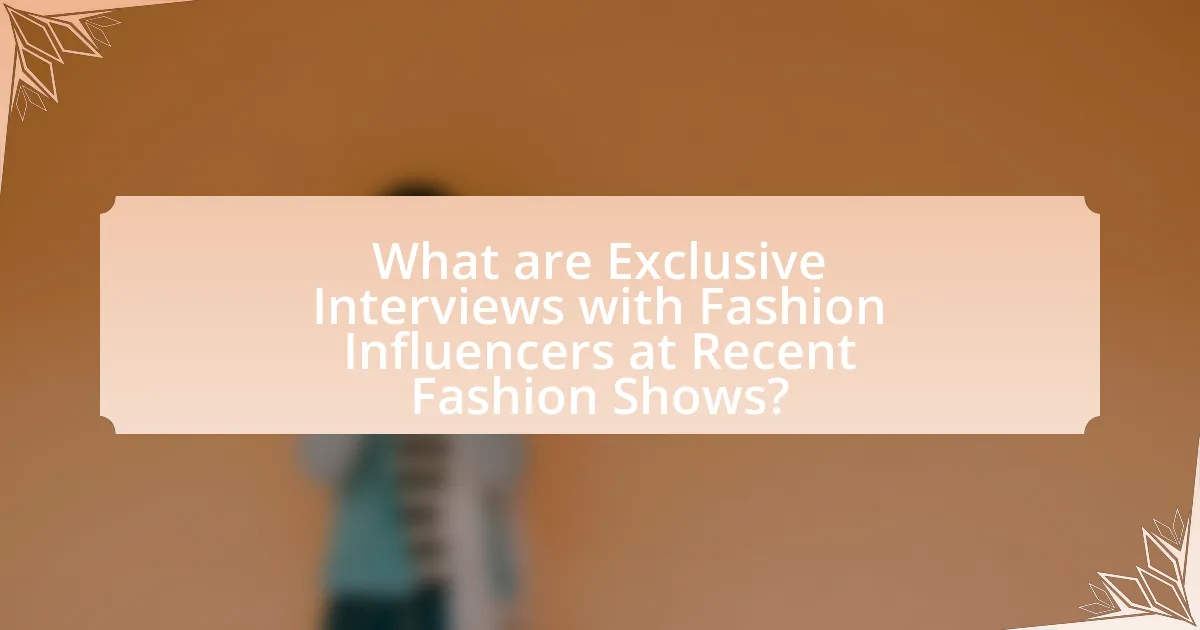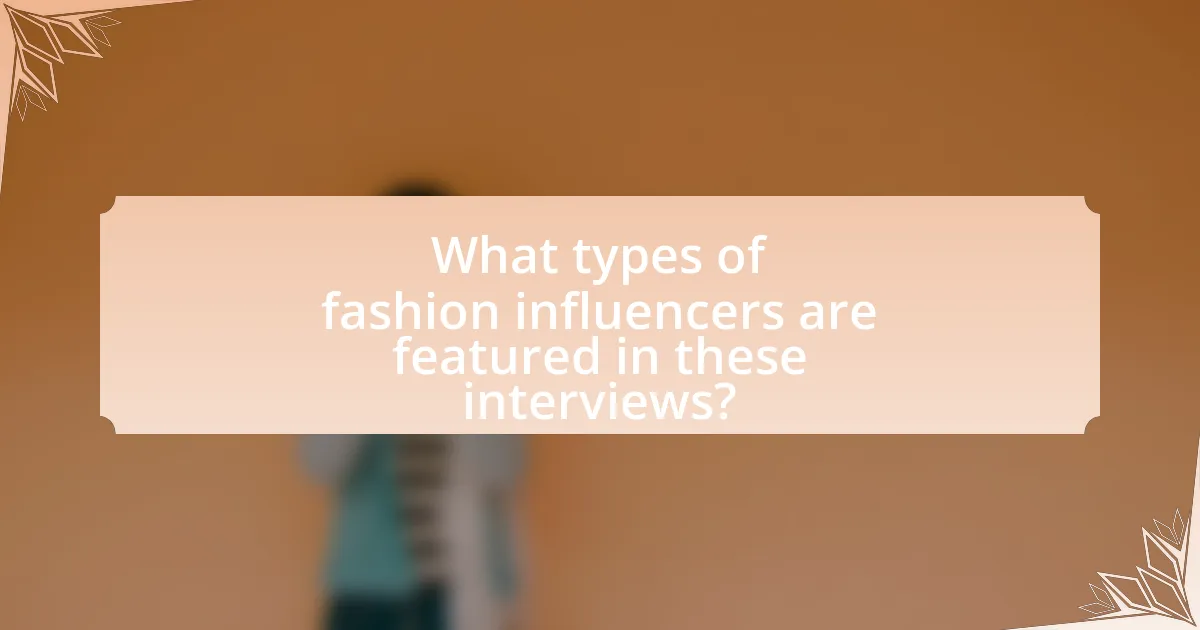Exclusive interviews with fashion influencers at recent fashion shows provide valuable insights into current trends, styles, and the personal experiences of these influencers. These interviews highlight the influencers’ perspectives on emerging trends such as sustainable fashion and inclusivity, shaping public perception and influencing consumer behavior. The article explores how influencers’ backgrounds affect their viewpoints, the significance of these interviews in promoting fashion shows and emerging designers, and the common themes discussed, including sustainability and diversity. Additionally, it examines the strategies influencers use to navigate the competitive environment of fashion events and offers practical tips for aspiring influencers.

What are Exclusive Interviews with Fashion Influencers at Recent Fashion Shows?
Exclusive interviews with fashion influencers at recent fashion shows are direct conversations that provide insights into the latest trends, styles, and personal experiences of these influencers during the events. These interviews often highlight the influencers’ perspectives on the showcased collections, their favorite designers, and the overall atmosphere of the fashion shows. For instance, during New York Fashion Week 2023, influencers shared their thoughts on emerging trends such as sustainable fashion and inclusivity, reflecting the industry’s evolving landscape.
How do these interviews shape the perception of fashion trends?
Interviews with fashion influencers significantly shape the perception of fashion trends by providing insights into the latest styles and the thought processes behind them. These conversations often highlight the influencers’ personal experiences and preferences, which can resonate with audiences and create a sense of authenticity. For instance, when influencers discuss their favorite pieces from a fashion show, they not only endorse specific trends but also contextualize them within broader cultural narratives, making them more relatable. This influence is supported by research indicating that 70% of consumers trust recommendations from influencers, which underscores their role in shaping public perception and acceptance of emerging fashion trends.
What insights do influencers provide about current fashion trends?
Influencers provide valuable insights into current fashion trends by highlighting emerging styles, popular colors, and key designers. They often share real-time observations from fashion shows, showcasing what is gaining traction among audiences. For instance, during recent fashion weeks, influencers noted a resurgence of 90s aesthetics and sustainable fashion choices, reflecting consumer demand for nostalgia and eco-consciousness. Their commentary is supported by social media engagement metrics, which indicate that posts featuring these trends receive higher interaction rates, validating their influence on public perception and purchasing behavior.
How do influencers’ backgrounds influence their perspectives?
Influencers’ backgrounds significantly shape their perspectives by informing their values, experiences, and the narratives they promote. For instance, an influencer from a diverse cultural background may emphasize inclusivity and representation in fashion, reflecting their lived experiences and the challenges faced by their community. Research indicates that personal history, including socioeconomic status and education, influences content creation and audience engagement, as influencers often draw from their unique experiences to connect with followers. This connection can lead to a more authentic and relatable brand image, which is crucial in the competitive landscape of social media.
Why are these interviews significant in the fashion industry?
Exclusive interviews with fashion influencers at recent fashion shows are significant in the fashion industry because they provide insights into trends, brand narratives, and consumer preferences. These interviews allow influencers to share their perspectives on emerging styles and the direction of the industry, which can shape public perception and influence purchasing decisions. For instance, a survey by the Fashion Institute of Technology found that 70% of consumers are more likely to purchase a product endorsed by an influencer they follow, highlighting the impact of these interviews on consumer behavior.
What role do influencers play in promoting fashion shows?
Influencers play a crucial role in promoting fashion shows by leveraging their large social media followings to generate buzz and visibility. They create content that showcases the event, including behind-the-scenes footage, outfit highlights, and live commentary, which engages their audience and drives interest. For instance, a study by the Digital Marketing Institute found that 49% of consumers depend on influencer recommendations when making purchasing decisions, illustrating the significant impact influencers have on consumer behavior and brand perception in the fashion industry.
How do interviews impact the visibility of emerging designers?
Interviews significantly enhance the visibility of emerging designers by providing them a platform to share their stories and creative visions. Through interviews, designers can articulate their unique perspectives, which helps to attract media attention and engage potential customers. For instance, when designers are featured in prominent fashion publications or online platforms, they gain exposure to wider audiences, increasing their brand recognition. This visibility is crucial in a competitive industry where emerging talent often struggles to stand out. Additionally, interviews can lead to collaborations and networking opportunities, further amplifying a designer’s reach within the fashion community.

What types of fashion influencers are featured in these interviews?
The interviews feature a diverse range of fashion influencers, including celebrity stylists, fashion bloggers, and social media influencers. Celebrity stylists are highlighted for their behind-the-scenes insights and connections within the industry. Fashion bloggers provide personal style perspectives and trend analyses, while social media influencers showcase their ability to engage audiences through platforms like Instagram and TikTok. This variety illustrates the multifaceted nature of influence in the fashion world, reflecting different avenues through which fashion is communicated and consumed.
How do different influencer categories affect the content of interviews?
Different influencer categories significantly affect the content of interviews by shaping the focus, tone, and depth of the discussion. For instance, fashion influencers often emphasize trends, personal style, and brand collaborations, leading to interviews that highlight visual aesthetics and industry insights. In contrast, lifestyle influencers may steer conversations towards broader topics such as wellness, travel, and personal experiences, resulting in a more narrative-driven interview style. Additionally, micro-influencers tend to foster intimate and relatable dialogues, while macro-influencers may focus on high-profile events and brand partnerships, influencing the overall direction and engagement level of the interview content. This variation is supported by the observation that interviews with niche influencers often yield more specialized insights, whereas those with mainstream influencers can attract a wider audience but may lack depth in specific areas.
What distinguishes a micro-influencer from a macro-influencer?
A micro-influencer is typically defined as an individual with a follower count ranging from 1,000 to 100,000, while a macro-influencer has a follower count exceeding 100,000. Micro-influencers often engage with their audience on a more personal level, leading to higher engagement rates, which can average around 7% compared to macro-influencers’ average of 1-3%. This distinction is significant in marketing strategies, as brands may prefer micro-influencers for niche targeting and authentic connections, while macro-influencers are often chosen for broader reach and visibility.
How do celebrity influencers contribute to the narrative of fashion shows?
Celebrity influencers shape the narrative of fashion shows by amplifying brand messages and trends through their vast social media reach. Their presence at these events generates significant media coverage and public interest, often leading to increased visibility for designers and collections. For instance, when a celebrity wears a designer’s piece, it can result in a spike in sales and social media engagement, as seen with the impact of celebrities like Rihanna and Kim Kardashian on brands like Fenty and Balenciaga. This dynamic creates a symbiotic relationship where influencers not only promote fashion but also help define its cultural relevance and direction.
What platforms are used for conducting these interviews?
The platforms used for conducting interviews with fashion influencers at recent fashion shows include Zoom, Instagram Live, and YouTube. These platforms facilitate real-time interaction and allow for a wide audience reach, making them ideal for engaging with fans and followers. For instance, Instagram Live enables influencers to connect directly with their audience during events, while Zoom is often used for more structured interviews that require a private setting. YouTube serves as a platform for posting recorded interviews, allowing for broader accessibility and engagement post-event.
How do social media platforms enhance the reach of these interviews?
Social media platforms enhance the reach of exclusive interviews with fashion influencers by providing a vast audience and facilitating immediate sharing. These platforms, such as Instagram, Twitter, and TikTok, allow users to share content rapidly, increasing visibility and engagement. For instance, a study by Pew Research Center indicates that 72% of the public uses some form of social media, which amplifies the potential audience for these interviews. Additionally, features like hashtags and tagging enable content to be discovered by users beyond the original followers, further expanding reach.
What role do fashion blogs and magazines play in this context?
Fashion blogs and magazines serve as crucial platforms for disseminating information and insights about fashion influencers during recent fashion shows. They provide coverage that highlights trends, styles, and the personal narratives of influencers, thereby shaping public perception and consumer behavior. For instance, a study by the Fashion Institute of Technology found that 70% of consumers are influenced by fashion blogs and magazines when making purchasing decisions, underscoring their impact on the industry.

What are the common themes discussed in these interviews?
The common themes discussed in these interviews include sustainability, diversity in fashion, and the impact of social media on trends. Sustainability is emphasized as influencers highlight eco-friendly practices and materials in their fashion choices. Diversity is a recurring topic, with many influencers advocating for representation across different body types, ethnicities, and genders in the fashion industry. Additionally, the influence of social media is frequently mentioned, as it shapes consumer behavior and trends, allowing influencers to connect directly with their audiences. These themes reflect current industry priorities and the evolving landscape of fashion.
How do influencers discuss sustainability in fashion?
Influencers discuss sustainability in fashion by emphasizing eco-friendly practices, ethical sourcing, and the importance of reducing waste. They often highlight brands that prioritize sustainable materials, such as organic cotton or recycled fabrics, and advocate for transparency in the supply chain. For instance, during recent fashion shows, influencers have pointed out the environmental impact of fast fashion and encouraged their followers to support slow fashion initiatives. This discussion is supported by statistics indicating that the fashion industry contributes to 10% of global carbon emissions, underscoring the urgency for sustainable practices.
What specific sustainable practices are highlighted by influencers?
Influencers highlight several specific sustainable practices, including the promotion of eco-friendly materials, advocating for slow fashion, and encouraging second-hand shopping. For instance, many influencers emphasize the use of organic cotton, recycled fabrics, and biodegradable materials in their fashion choices, which significantly reduce environmental impact. Additionally, they often discuss the importance of slow fashion, which focuses on quality over quantity, urging consumers to invest in timeless pieces rather than fast fashion items. Furthermore, influencers frequently share their experiences with thrift shopping and upcycling, showcasing how these practices contribute to sustainability by extending the lifecycle of clothing and reducing waste.
How do influencers perceive the future of sustainable fashion?
Influencers perceive the future of sustainable fashion as increasingly vital and transformative for the industry. They believe that consumer demand for eco-friendly practices will drive brands to adopt sustainable materials and ethical production methods. Influencers often highlight the growing awareness among consumers regarding environmental issues, which is pushing brands to innovate and prioritize sustainability. For instance, a survey by McKinsey & Company indicates that 67% of consumers consider sustainability when making a purchase, reinforcing influencers’ views on the necessity of sustainable practices in fashion.
What fashion trends are frequently mentioned in these interviews?
Fashion trends frequently mentioned in these interviews include oversized silhouettes, sustainable materials, and bold colors. Influencers highlight oversized silhouettes as a key trend for comfort and style, while sustainable materials are increasingly emphasized due to growing environmental awareness in the fashion industry. Additionally, bold colors are noted for making a statement on the runway, reflecting a shift towards more vibrant and expressive fashion choices. These trends are supported by the current focus on comfort, eco-friendliness, and individuality in contemporary fashion discussions.
How do influencers predict upcoming trends based on their experiences?
Influencers predict upcoming trends based on their experiences by analyzing past fashion cycles, observing consumer behavior, and engaging with their audience for feedback. Their firsthand experience at fashion shows allows them to identify emerging styles and themes that resonate with their followers. For instance, influencers often note the popularity of specific colors, fabrics, or silhouettes showcased during events, which can indicate a shift in consumer preferences. Additionally, data from social media interactions, such as likes and shares, provides concrete evidence of what styles are gaining traction, further informing their predictions.
What trends have been consistently popular across multiple interviews?
Sustainable fashion has been a consistently popular trend across multiple interviews with fashion influencers at recent fashion shows. Influencers frequently emphasize the importance of eco-friendly materials and ethical production practices, reflecting a growing consumer demand for sustainability in the fashion industry. For instance, a survey by McKinsey & Company in 2021 indicated that 67% of consumers consider the use of sustainable materials when making fashion purchases, highlighting the trend’s relevance and impact on consumer behavior.
What challenges do influencers face when attending fashion shows?
Influencers face several challenges when attending fashion shows, including intense competition for attention, logistical issues, and the pressure to create engaging content. The competitive nature of fashion shows means influencers must navigate a crowded environment where many are vying for the same spotlight, making it difficult to stand out. Logistical challenges often arise from tight schedules, limited access to shows, and the need to coordinate with brands for coverage, which can lead to stress and missed opportunities. Additionally, the pressure to produce high-quality, engaging content in real-time can be overwhelming, as influencers strive to meet audience expectations while capturing the essence of the event.
How do influencers navigate the competitive environment of fashion events?
Influencers navigate the competitive environment of fashion events by leveraging their personal brand, networking strategically, and utilizing social media to amplify their presence. They establish a unique identity that resonates with their audience, which helps them stand out among numerous attendees. Influencers often build relationships with designers, brands, and other influencers, creating collaborative opportunities that enhance their visibility. Additionally, they actively engage with their followers on platforms like Instagram and TikTok, sharing real-time updates and exclusive content from events, which increases their relevance and reach. This approach is supported by the fact that influencers with strong engagement rates can attract significant attention from brands, leading to partnerships and sponsorships that further solidify their position in the competitive landscape of fashion events.
What strategies do influencers use to stand out during interviews?
Influencers use several strategies to stand out during interviews, including showcasing their unique personal style, engaging storytelling, and leveraging social media presence. By wearing distinctive outfits that reflect current trends or their personal brand, influencers capture attention visually. Engaging storytelling allows them to connect emotionally with the audience, making their experiences relatable and memorable. Additionally, influencers often promote their interviews across various social media platforms, enhancing visibility and engagement, which is supported by the fact that 70% of consumers are more likely to remember a brand when they see it on social media (Source: Nielsen). These strategies collectively enhance their appeal and effectiveness during interviews.
What practical tips can be derived from these interviews for aspiring influencers?
Aspiring influencers can derive practical tips such as the importance of authenticity, consistent branding, and engagement with their audience. Authenticity is crucial, as influencers who share genuine experiences and opinions tend to build stronger connections with their followers. Consistent branding helps in establishing a recognizable identity, which is essential for standing out in a crowded market. Engagement with the audience, through responding to comments and creating interactive content, fosters community and loyalty. These insights are supported by the experiences shared by successful influencers during interviews, highlighting that these strategies have contributed to their growth and influence in the fashion industry.
How can aspiring influencers effectively network at fashion shows?
Aspiring influencers can effectively network at fashion shows by actively engaging with industry professionals and leveraging social media platforms. Attending shows with a clear strategy, such as preparing thoughtful questions for designers and other influencers, enhances interaction quality. Additionally, utilizing social media to share live updates and tagging relevant brands and individuals increases visibility and fosters connections. Research indicates that 70% of influencers report that networking at events leads to collaborations, highlighting the importance of building relationships in person.
What best practices should influencers follow when conducting interviews?
Influencers should prioritize preparation, active listening, and authenticity when conducting interviews. Preparation involves researching the interviewee and formulating relevant questions to ensure a smooth conversation. Active listening allows influencers to engage meaningfully, responding to the interviewee’s answers and asking follow-up questions that deepen the discussion. Authenticity fosters trust and relatability, encouraging interviewees to share more personal insights. These practices enhance the quality of the interview, making it more engaging for the audience and providing valuable content.